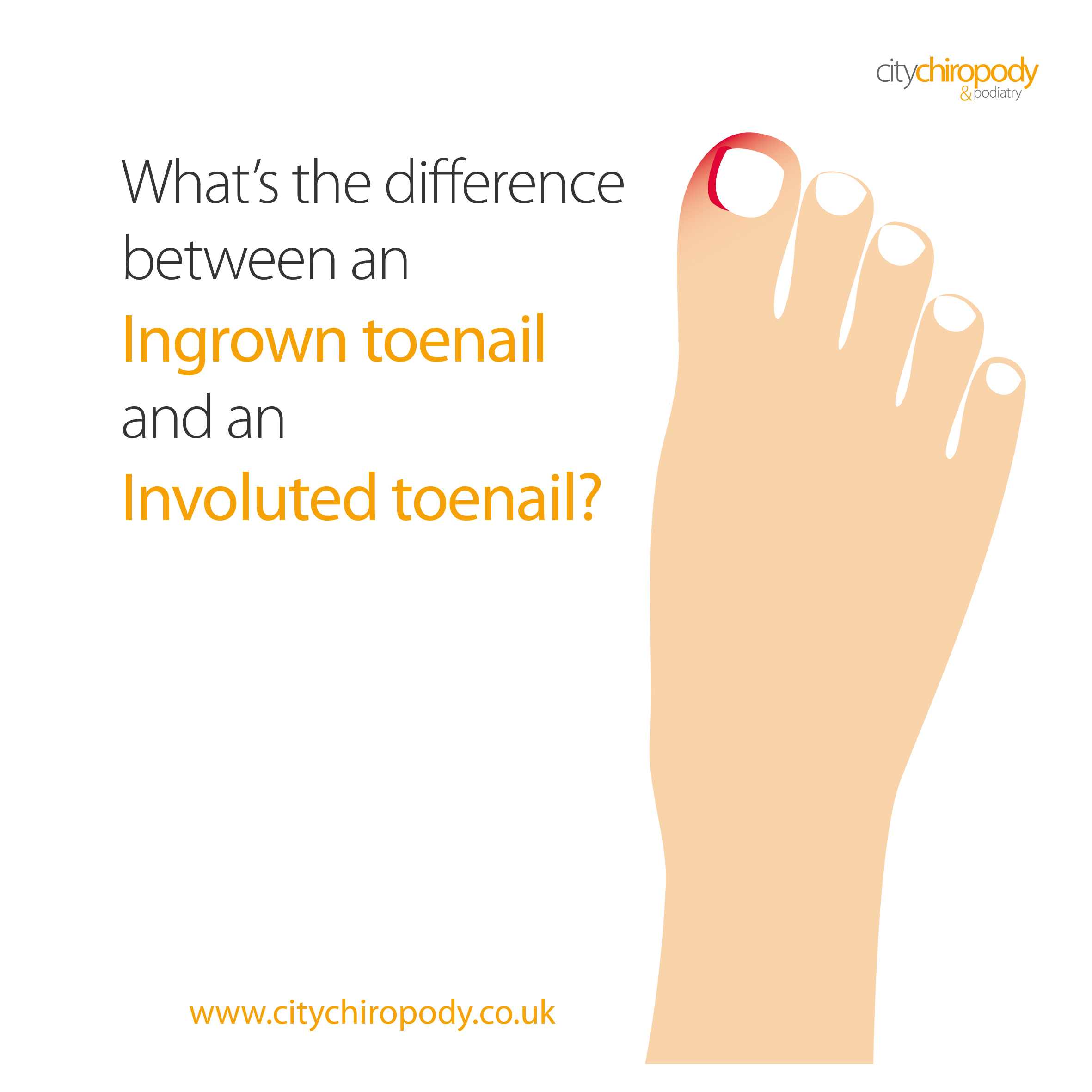What Causes Involuted Toenails?
Trauma, wearing shoes that squeeze the toenails, or genetics can cause some people to develop ingrown nails. These changes in the nail are called nail dystrophy. People who have diabetes or poor circulation can be more at risk. I’m often asked is there a difference between ingrown toenails and involuted toenails.
What is an Involuted Toenail?
Involuted toenails are nails that curve and press down the sides (the technical term is nail sulci). The nails press down into the sulci, causing a build-up of hard skin. This can be painful, especially if the nail itself is a bit thick or the shoes are squashing the toe. The pain is usually relieved when you take your footwear off. These types of nails rarely become infected, and apart from the curved nail, the toe and the skin around the nail looks relatively normal.
What is an Ingrown Toenail?
An ingrown toenail looks different. The nail is usually a thin, normal-looking nail, but the skin next to the nail is often red, swollen and sometimes there is dried blood visible in the toenail. It’s also usually painful, especially in shoes but also even when there is no pressure on the toe. Most patients tell me it even hurts when they are in bed and the sheets touch it!
What Causes Involuted Toenails?
One of the most common reasons for nail deformities is repeated trauma to the nail. This can be constant pressure from shoes that are either too tight or have improper arch support or a toe injury. Another reason can be a genetic predisposition to the condition.
What Causes Ingrown Toenails?
Trauma, wearing shoes that squeeze the toenails, or genetics can cause some people to develop ingrown nails. These changes in the nail are called nail dystrophy. People who have diabetes or poor circulation can be more at risk.
How can I prevent involuted toenails and ingrown toenails?
Pain from involuted toenails and ingrown toenails can be avoided in much the same ways as one another. By following these simple steps, you can try to prevent ingrown and involuted toenails before they become a problem.
Firstly, you should practice good general foot hygiene and ensure that when cutting your toenails, you cut them correctly. You may think cutting your toenails is easy, but there is actually a ‘best’ way to cut your nails. To begin, ensure that you do not cut them too short; you should aim to leave them long enough so that they lie loosely on the surrounding skin of your toes. Secondly, do not cut your toenails in a curved shape; they should always be cut straight across; cutting them in a curve could promote them to grow incorrectly into the skin. You should also always aim to cut your toenails while dry, as this will make them less likely to tear or rip.
When aiming to prevent ingrown and involuted toenails, you should also be sure that your footwear isn’t causing you unnecessary problems. Try to avoid wearing pointed shoes that squeeze the toes into an unnatural shape.
When buying new shoes, you should always measure your feet to ensure that they haven’t changed since the last time you measured them. Opt for shoes that fit comfortably and have a larger toebox area.
If you do notice some pain or abnormalities with your toenails, you should see a podiatrist as soon as possible for professional treatment.
Treatment for Ingrown Toenails
I’d always suggest treatment sooner rather than later with this type of problem as the longer it’s left, the harder it is to deal with simply. Mostly it’s a simple matter of carefully clipping away the piece of nail that’s embedded into the skin (podiatrists can do this without pain and usually don’t mind giving advice if you speak to us first). Never attempt to do this yourself – it usually leads to the toe becoming worse!
Occasionally, if the ingrowing nail is very bad, we have to use a local anaesthetic to enable us to clear the problem without worrying how much it might hurt you.
Treatment for Involuted Toenails
Involuted toenails can usually be dealt with much more simply. We can clip the nail and gently remove the hard skin from the sides. Again never attempt this yourself, as even a tiny break in the skin can lead to you creating an even worse problem as they can become infected very easily.
If you’re suffering from either of these problems, contact us today, and we will be able to help!
APPOINTMENTS
FAQ's
OUR LOCATIONS
ABOUT US
CONTACT US
ADVICE

Chiropody and Podiatry Clinics In:
Barbican EC2
Fenchurch Street EC3
Loughton IG10
FOLLOW US ON SOCIAL MEDIA
Copyright City Chiropody & Podiatry Ltd | Company Number - 12815477 | Chiropody and Podiatry Clinics In London & Essex
Website design by Dynamic Pear

